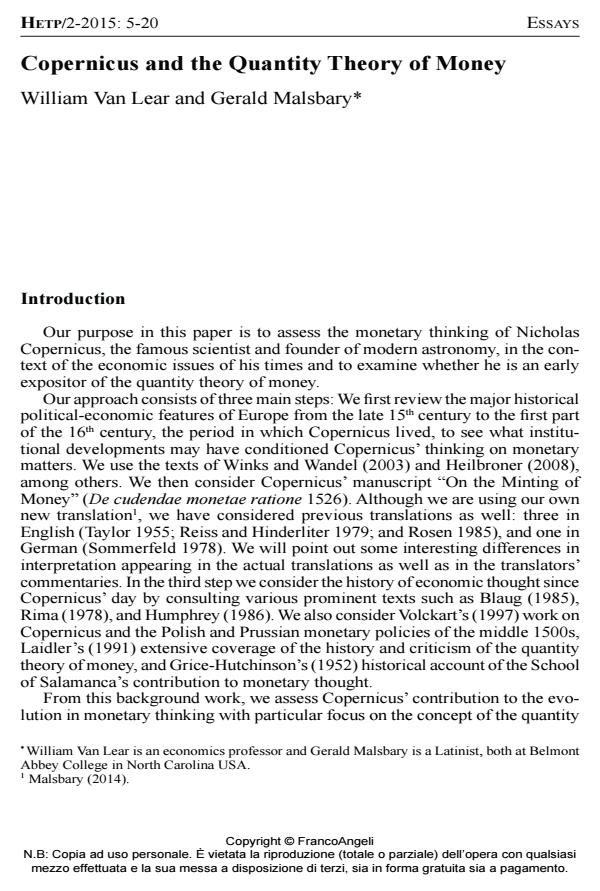Copernicus and the Quantity Theory of Money
Titolo Rivista HISTORY OF ECONOMIC THOUGHT AND POLICY
Autori/Curatori William VanLear
Anno di pubblicazione 2015 Fascicolo 2015/2 Lingua Italiano
Numero pagine 16 P. 5-20 Dimensione file 211 KB
DOI 10.3280/SPE2015-002001
Il DOI è il codice a barre della proprietà intellettuale: per saperne di più
clicca qui
Qui sotto puoi vedere in anteprima la prima pagina di questo articolo.
Se questo articolo ti interessa, lo puoi acquistare (e scaricare in formato pdf) seguendo le facili indicazioni per acquistare il download credit. Acquista Download Credits per scaricare questo Articolo in formato PDF

FrancoAngeli è membro della Publishers International Linking Association, Inc (PILA)associazione indipendente e non profit per facilitare (attraverso i servizi tecnologici implementati da CrossRef.org) l’accesso degli studiosi ai contenuti digitali nelle pubblicazioni professionali e scientifiche
This paper examines Nicholas Copernicus’ monetary thinking to ascertain whether he is an early expositor of the quantity theory of money. The paper reviews the historical setting of the 1500s, considers the history of economic thought that pertains to the quantity theory of money, and considers prior translations and interpretations of Copernicus’ manuscript "On the Minting of Money" with our own translation. The paper finds that Copernicus’ monetary thinking is noteworthy for associating monetary policy instability with various economic effects, but he is not a quantity theorist or an advocate of policy positions associated with quantity theorists.;
Keywords:Copernicus, monetary theory, quantity theory, metalism, the Great Inflation
Jel codes:B11, B31, N1
- Arestis P. and P. Howells (2001-2002). The 1520–1640 “Great Inflation”: An Early Case of Controversy on the Nature of Money, Journal of Post Keynesian Economics, vol 24, no.2: 181-203.
- Blaug M. (1985). Economic Theory in Retrospect. Cambridge, Cambridge University Press.
- Braudel F. and F. Spooner (1971). Prices in Europe from 1450 to 1750. In Rich and Wilson (eds.)(1971): 374-449.
- Copernicus N. (1526). De cudendae monetae ratione. For a critical Latin edition and modern German translation, see Sommerfeld (1978). For English translations see Taylor (1955), Reiss and Hinderliter (1979), Rosen (1985), and Malsbary (2014).
- Flynn D., A. Giraldez and R. Von Glahn (eds.)(2003). Global Connections and Monetary History, 1470 – 1800, Aldershot and Brookfield, VT, Ashgate Publishing.
- Grice-Hutchinson M. (1952). The School of Salamanca: Readings in Spanish Monetary Theory, 1544-1605, http://mises.org/books/salamanca_grice-hutchinson.pdf (August 2013).
- Heilbroner R. (2008). The Making of Economic Society, 12th ed. Upper Saddle River, Pearson.
- Humphrey T. (1986). Essays on Inflation, fifth edition. Richmond V.A. Federal Reserve Bank of Richmond.
- Kugler P. and P. Bernholz (2007). The Price Revolution in the 16th Century: Empirical Results from a Structural Vectorautoregression Model, Working paper, University of Basel.
- Kuhn T. (1957[1985]). Copernican Revolution: Planetary Astronomy in the Development of Western Thought, New York, MFJ Books. Laidler D. (1991). The Quantity Theory is Always and Everywhere Controversial – Why?, The Economic Record, 67, December: 289-306.
- Malsbary, G. (2014) Essay on Money: “On the Minting of Money” by Nicolas Copernicus (1526). Translated from the original Latin by Gerald Malsbary. Edited by Benko R. and C. Kadlec with a Foreword by L. Lehrman. Washington, D.C. Laissez-Faire Books.
- Munron J. (2003). The Monetary Origins of the Price Revolution: South German Silver Mining, Merchant Banking, and Venetian Commerce, 1470-1540, in Flynn, Giraldez and Von Glahn (eds.)(2003): 1-43.
- Munron J. (2008). Money, Prices, Wages, and Profit Inflation in Spain, the Southern Netherlands, and England During the Price Revolution Era, ca. 1520 - ca. 1650. Munich
- Personal RePEc Archive, n° 10849, October.
- Oresme N. (c. 1355 [1956]), Johnson C. (ed). The De Moneta of Nicholas Oresme and English Mint Documents, London, etc.: Thomas Nelson and Sons, Ltd.
- Reiss T. and R. Hinderliter (1979). Money and Value in the Sixteenth Century: The Monete Cudendae Ratio of Nicholas Copernicus, Journal of the History of Ideas. Vol. 40: 293-313.
- Rich E.E and C.H. Wilson (eds.)(1971). Cambridge Economic History of Europe, IV, Cambridge: Cambridge University Press: 374-449
- Rima I. (1978). Development of Economic Analysis, third edition, Homewood: Irwin.
- Robinson J. (1970). Quantity Theories Old and New, Journal of Money, Credit, and Banking, vol.2, n°.4, 1970, 504-12.
- Rosen E. (1985)(ed.). Nicholas Copernicus: Complete Works, Vol 3, Baltimore, Johns Hopkins University Press (pages 167-215 contain an English translation of Copernicus’ treatise on money with introduction, variant versions and commentary).
- Sommerfeld E. (1978). Die Geldlehre des Nicholaus Copernicus. Texte, Übersetzungen, Kommentare, Vaduz/Liechtenstein, Topos Verlag.
- Taylor J. (1955). Copernicus on the Evils of Inflation and the Establishment of a Sound Currency, Journal of the History of Ideas, Vol. 16: 540-7.
- Volckart O. (1997). Early Beginnings of the Quantity Theory of Money and their Context in Polish and Prussian Monetary Policies, c. 1520-1550, Economic History Review, Vol. 50, no 3: 430-49.
- Winks R. and L. Wandel. (2003). Europe in a Wider World, New York, Oxford University Press.
- Wray R. (1998). Understanding Modern Money, Cheltenham, Edward Elgar
William VanLear, Copernicus and the Quantity Theory of Money in "HISTORY OF ECONOMIC THOUGHT AND POLICY" 2/2015, pp 5-20, DOI: 10.3280/SPE2015-002001